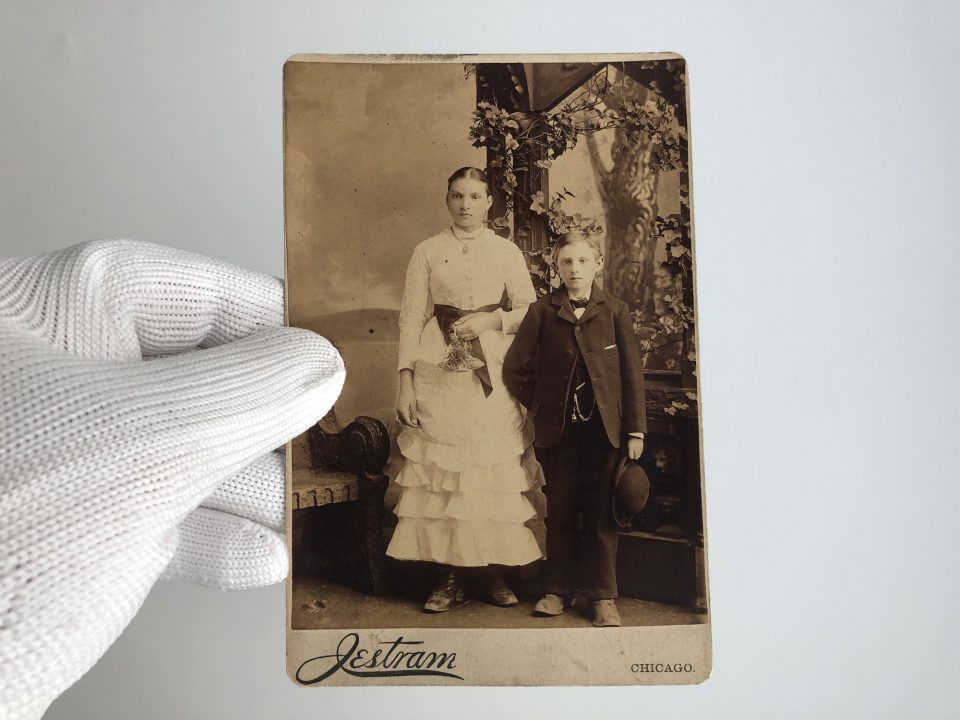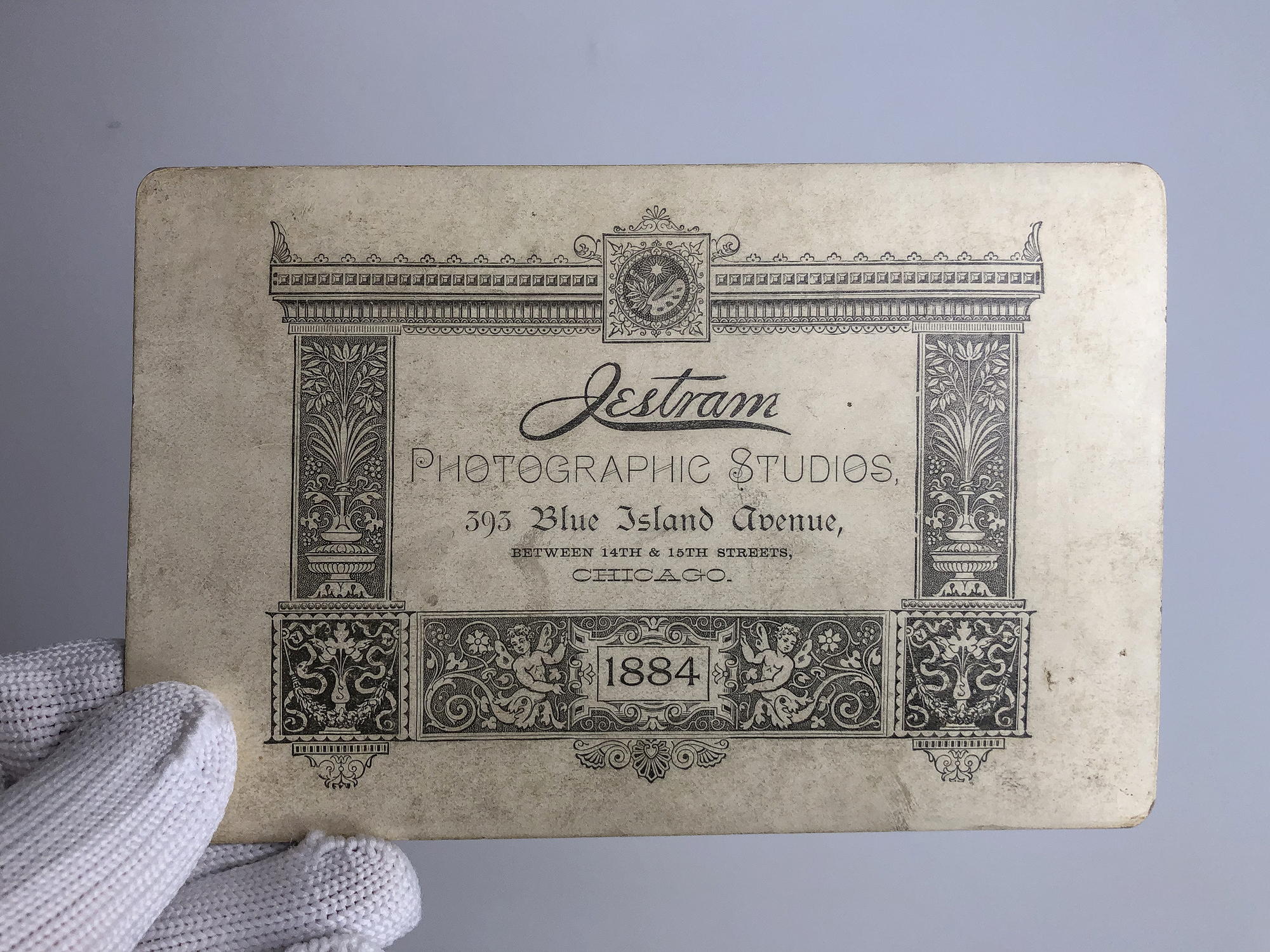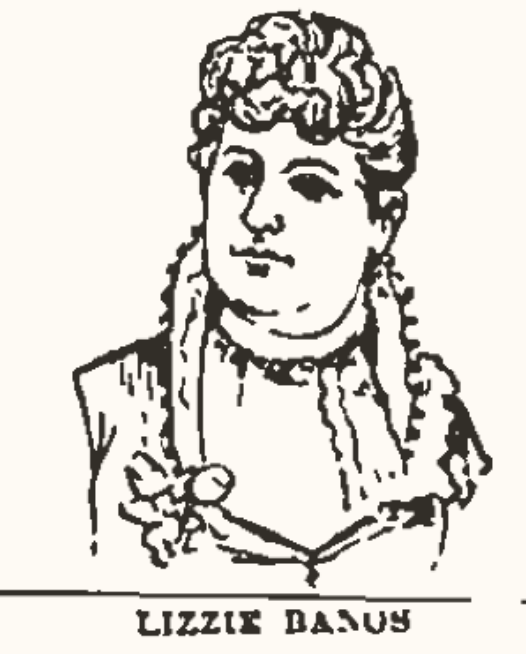

Between 14th & 15th Streets, Chicago. 1884
Henry Jestram was a portrait photographer who created cabinet card portraits from his studio at 3893 Blue Island Street in Chicago in the 1880s. Jestram’s cabinet card imprint placed his studio between 14th and 15th Streets. A quick look at Google Street View reveals that nothing of his studio location still remains. On one side of the street are modern glass office buildings, and on the opposite side of the street is a grassy area that may be a park.
Jestram had the unusual but helpful habit of putting the year of the photograph on this cards, making them absolutely foolproof to date.
While many examples of Jestram’s photography work can be found online, I could find little about his personal life, except for one tantalizing fact for which he may be best known.
Wikipedia cites a bizarre episode reported in the April 17, 1888 edition of The Washington Post claiming that wealthy photographer Henry Jestram had died in an insane asylum after having paid huge amounts of his fortune to a notorious pair of Chicago spiritualists called The Bangs Sisters for performing séances. The sisters became scapegoats in Jestram’s death.
In that 1888 article titled, “Chicago’s Bogus Spiritualists,” The Washington Post article said, “Lizzie and May Bangs, under the firm name of the Bangs Sisters, conduct the leading spiritualistic establishment in Chicago. . . Their elegant parlors have been crowded by day as well as by night and money flowed into their coffers in large streams.
“
An 1888 newspaper account regarding Henry Jestram and the Bangs Sisters (full text)
The Hornellsville Weekly Tribune newspaper of Hornellsville, New York published the following article about Henry Jestram and the Bangs Sisters on page 1 in April 1888. It gives one explanation of how he lost his sanity. I’ve transcribed the article here verbatim, but the copy was difficult to read in places so some illegible words have been substituted with Xs.
“The Bangs Sisters
The Two Bouncing Mediums of the City of Chicago


Almost simultaneously with the Marsh-Diss DeBar spirit picture sensation in New York, they have had the Jestram-Bangs sisters sensation in Chicago. Jestram is a photographer, and he has been so wrought upon by the Bangs sisters that he has become insane. The method by which these women robbed Jestram of his senses was the slate writing common among spiritual mediums. He was completely caught by the process one evening in a XXXXX seance, and at once became XXXXX in spiritualism and took to reading spiritualistic literature, He also began a regular attendance in the seances. At these meetings Jestram paid for communications from absent friends in good money, and undoubtedly got bogus communications. Two slates were put together with a slate pencil between as is common in such cases, and the spirits of Jestram’s two children, who died aged respectively 4 months and 24 hours, wrote him loving messages. Considering their age at death, their education must have been given them entirely in the spirit world. August Spies also consented to send a message. Mr. Jestram knew these communications were genuine, for he held the slates in his hands and heard the pencil when it began to write. Unfortunately the convert was seized with a desire common to converts, that is to convert everyone else. But his friends would have none of his newfound treasure, and laughed him to scorn. This ridicule of that which he held sacred, it is said, drove him crazy.
Now comes the denouement. At a recent seance given by the Bangs sisters two policemen placed themselves in a convenient position, and, when the alleged spirit of a Russian princess appeared, sprang forward to the cabinet and clutched the spirit with material hands. It proved to be Miss May Bangs clad in royal robes. The officers had to draw their revolvers to keep the friends and believers at bay until a patrol wagon arrived. The sisters were taken to the police station and locked up. They were charged with running a show without a license, and obtaining money under false pretenses.”
Other prominent victims
Whatever the cause of his sad demise, clearly Jestram was only one in a long line of wealthy men to fall prey to the wily Bangs Sisters. And sadly, even though he was apparently a quite successful photographer, his legacy is inextricably tied to the Bang Sisters as well.
For a while the sisters sold spirit paintings at $1,500 a piece, with Dr. Issac Funk of the Funk and Wagnalls encyclopedia being a frequent collector.
And in 1901, May was once again married, this time based on the proclamations of the groom’s dead mother, and within two years she left her latest husband, a millionaire leather manufacturer, divorced and broke. That story was reported by the Chicago Daily Tribune.
Listen to my podcast episode about Henry Jestram and the Bangs Sisters
Podcast Full Episode Transcript
In this episode, a bit of fascinating and bizarre photography history. Was Chicago photographer Henry Jestram driven to the insane asylum and his death because of seances performed by the notorious Bangs Sisters?
Intro
Hey everybody, welcome back to another episode of the Fine Art Photography Podcast.
It’s no secret that the United States has experienced an explosion of interest in the paranormal over the past decade or so. There are television shows, movies, and countless YouTube channels dedicated to searching for ghosts, talking to ghosts, and trying to catch images of ghosts.
It seems every town has a ghost tour and all sorts of electronic and old school devices can be used to communicate with the dead. One classic tool popular in horror shows and with the general public are Ouija boards. They can still be purchased, although they are less popular than they were in the 1960s and 70s when the occult had its last big heyday. According to Smithsonian Magazine, the Ouija board originated from the original talking boards or spirit boards used in Spiritualism, a belief that the living can communicate with the dead.
Spiritualism took root in the U.S. in the 1840s in upstate and western New York State, in a region rich with religious fervor that birthed many religious movements, including Millerism, which became the Seventh Day Adventists, and Mormonism.
Spiritualism thrived from the 1840s to the 1920s, and reached it’s Zenith in the 1890s. Spiritualists believed that the after life was a place lively with spirit activity, that spirits continued to evolve after death, and that spirits were more advanced that the living and therefore could provide wisdom and insight. Of course, spiritualists believed that the living could contact the dead, using people with special sensitivities or abilities who were called spiritual mediums. Mediums could contact and speak to spirit guides, ghostly gurus who were available to offer advice.
In the city of Chicago, a pair of industrious but notorious sisters set up a franchise of spirit medium seance parlors around the city, where they contacted the dead for a fee. Among their parlor tricks, the Bangs Sisters — May and Lizzie — would produce a piece of slate with a message from the dead that had been inscribed in chalk by an invisible hand. They could also move furniture around the room.
The sisters were proven to be frauds on several occasions and they were even arrested for operating a business without a license, for which they were fined, in spite of their claims that they were not a business, but were in fact ministers.
In an 1888 article titled, “Chicago’s Bogus Spiritualists,” The Washington Post said, “Lizzie and May Bangs, under the firm name of the Bangs Sisters, conduct the leading spiritualistic establishment in Chicago. . . Their elegant parlors have been crowded by day as well as by night and money flowed into their coffers in large streams.”
They were skilled enough with their ruses to fool even educated and successful businessmen. They were able to trick one of the investors in the first typewriter by using a so-called spirit typewriter to produce messages from Moses and other famous characters.
May was able to dupe a wealthy chemical magnate into marrying her by convincing him that his deceased wife had commanded him to do so.
This brings us to our topic — the wealthy Chicago-based portrait photographer Henry Jestram.
I only learned about Jestram after finding one of his antique cabinet card portraits in a shop. The card features an amber-hued portrait of a young brother and sister, standing side by side — her in a fine white frilly dress and he in his suit and pocket watch. Both of them wearing scuffed and dirty boots.
As is my practice, I began researching Jestram to see what I could learn about his life and work.
I thought for sure that there would be a lot of information about him since he practiced his craft in a major American city. Unfortunately, I wasn’t able to learn much about him. But here is what I know.
Henry Jestram was a portrait photographer who created cabinet card portraits from his studio at 3893 Blue Island Street in Chicago in the 1880s. Jestram’s cabinet card imprint placed his studio between 14th and 15th Streets. A quick look at Google Street View reveals that nothing of his studio location still remains. On one side of the street are modern glass office buildings, and on the opposite side of the street is a grassy area that may be a park.
Jestram had the unusual, but helpful, habit of putting the year of the photograph on this cards, making them absolutely foolproof to date. This photo was made in 1884.
While many examples of Jestram’s photography work can be found online, I could find little about his personal life, except for one tantalizing fact for which he may be best known.
Wikipedia cites a bizarre episode reported in the April 17, 1888 edition of The Washington Post claiming that a wealthy photographer named Henry Jestram had died in an insane asylum after having paid huge amounts of his fortune to a notorious pair of Chicago spiritualists called The Bangs Sisters for performing numerous seances.
The sisters became scapegoats in Jestram’s death. Did he go insane as a result of the seances? Or perhaps after giving away his fortune to the Bangs Sisters?
I found an original newspaper article from 1888 that discussed the Jestram-Bangs case. Here’s what the article said, and I’m quoting:
“At these meetings Jestram paid for communications from absent friends in good money, and undoubtedly got bogus communications. Two slates were put together with a slate pencil between as is common in such cases, and the spirits of Jestram’s two children, who died aged respectively 4 months and 24 hours, wrote him loving messages. Considering their age at death, their education must have been given them entirely in the spirit world…”
The article went on to say: “Mr. Jestram knew these communications were genuine, for he held the slates in his hands and heard the pencil when it began to write. Unfortunately the convert was seized with a desire common to converts, that is to convert everyone else. But his friends would have none of his newfound treasure, and laughed him to scorm. This ridicule of that which he held sacred, it is said, drove him crazy.”
And there you have it.
Whatever the cause of his sad demise, clearly Jestram was only one in a long line of wealthy men to fall prey to the wily Bangs Sisters. And sadly, even though he was apparently a quite successful photographer, his legacy is inextricably tied to the Bang Sisters as well.
For a while the sisters sold spirit paintings at $1,500 a piece, with Dr. Issac Funk of the Funk and Wagnalls encyclopedia being a frequent collector.
And in 1901, May was once again married, this time based on the proclamations of a dead mother, and within two years she rendered her latest husband, a millionaire leather manufacturer, divorced and broke. That story was reported by the Chicago Daily Tribune.
Well I hope you found this strange photographic history interesting.
That’s all I’ve got for now.
As always, you can find full episode transcripts and links to sources on my blog at i catch shadows dot com.
Thanks for listening. I’ll talk to you again real soon.
Sources and Links
Baltimore Magazine. “Not Dead Yet.”
Hornellsville Weekly Tribune. “The Bangs Sisters: The Two Bouncing Mediums of the City of Chicago.” Hornellsville, New York. Friday, April 20th, 1888. Pg. 1.
Washington Post. “Chicago’s Bogus Spiritualists”. Washington, D.C. April 17, 1888. p. 6.
Wikipedia. “The Bangs Sisters.”
Wikipedia. “Spiritualism.”
